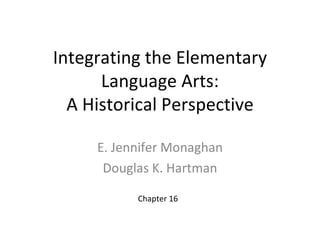
Monaghan Hartman (2010) Integrating the Elementary Language Arts
- 1. Integrating the Elementary Language Arts: A Historical Perspective E. Jennifer Monaghan Douglas K. Hartman Chapter 16
- 2. Toward Defining the Language Arts … • “Our goal is to define … what students should learn in the English language arts—reading, writing, listening, speaking, viewing, and visual representing.” International Reading Association/National Council of Teachers of English (IRA/NCTE). (1996). Standards for the English Language Arts. Newark, DE: International Reading Association/National Council of Teachers of English.
- 3. 1620s to 1780s Sequential Teaching of Reading & Writing Reading the Bible is the route to salvation New-England Primer (n.p.). (1727). Boston: S. Kneeland & T. Green.
- 4. 1780s to 1840s Integrating Speaking & Spelling Instruction Oral spelling is the route to reading acquisition Webster, N. (1843). The elementary spelling book; being an improvement on the American Spelling Book (p. 20). New York: Cooledge & Brother. (Original work published 1829).
- 5. 1840s to 1880s Pestalozianism & Schoolbooks A shift toward child-centered reading instruction William Holmes McGuffey (1837). Eclectic First Reader (p. 14). Cincinnati: Truman & Smith. Reproduced in John H. Westerhoff III (1978). McGuffey and His Readers: Piety, Morality, and Education in Nineteenth-Century America (p. 115). Nashville, TN: Abingdon.
- 6. 1840s to 1880s Pestalozianism & Schoolbooks (continued) A shift toward child-centered writing instruction Frost, J. (1839). Easy exercises in composition (p. 24). Philadelphia: W. Marshal. Reproduced in Schultz, L.M. (1999), The young composers: Composition’s beginning in nineteenth-century schools (p. 52). Carbondale: Southern Illinois University Press.
- 7. 1880s to 1930s Progressivism & the Integration of Literacy Instruction Francis Wayland Parker Source: http://www.ucls.uchicago.edu/photo_album/1809s/parker.html
- 8. 1930s to 1970s Disintegrating the Language Arts The Whole Word Approach Kleiser, C., Ettinger, W.L., & Shimer, E.D. (1917). The Progressive road to reading: Story steps (p. 7). Boston: Silver, Burdett.
- 9. 1980s to 1990s Integrating the Language Arts Emergent literacy, process writing, whole language, & literature- based reading Mavrogenes, N.A. (1987). Young children composing then and now: Recent research on emergent literacy. Visible Language, 21, p. 281.
- 10. 1990s to 2010 Citations of the Words “Reading,” “Writing,” “Language Arts,” and “Literacy” in Public Law 107-110 (2001), the No Child Left Behind law Reading Writing Language Arts Literacy COMBINED TOTALS -249 26* 7 108 The disparity in favor of reading and reading instruction over writing and Where We Are Now in the Era writing instruction is obvious. * This total includes a deduction of 3 citations of the phrase “in writing.” of NCLB Sources: TITLE 1 Improving the Academic Achievement of the Disadvantaged Sections 1001-1004; Part A, Improving Basic Programs, sections 1111-1120B; Part B, Student Reading Skills Improvement, sections 1201-1208; Subpart 2, Early Reading First, sections 1221-1226; Subpart 3, William F. Goodling Family Literacy, sections 1231-1242; Subpart 4. Improving Literacy…School Libraries, section 1251; Part C, Education of Migratory Children, sections 1301-1309. TITLE 2 Preparing, Training, and Recruiting High Quality Teachers and Principals Subpart 2. National Writing Project, sections 2331-2332. Public Law 107-110, the No Child Left Behind of 2001. Retrieved November 29, 2010, from http://www2.ed.gov/policy/elsec/leg/esea02/index.html Renewed emphasis on reading rather than writing instruction
- 11. Summary of Chapter Era Years Themes/Events Reading is taught before writing The New England Primer: because it is through reading Sequential Teaching of Reading 1620s to 1780s that the young acquire the & Writing values (at this time, the religious values) of adults. In the 1730s, spelling books emerge as the key text for Noah Webster’s Spelling Books: American reading instruction, Integrating Speaking & Spelling 1780s to 1840s which is based on the alphabet with Reading Instruction method. Noah Webster’s spellers outstrip all others in their sales. (Monaghan & Hartman, 2010)
- 12. Summary of Chapter Era Years Themes/Events The sterility of the alphabet method and rote learning gives Pestalozzianism & Child- rise to reform. Reformers Centered Schoolbooks: invoke the child-centered 1820s to 1880s Parallel Shifts in Reading & principles of Johann Pestalozzi Writing Materials to introduce child-centered reading and writing instructional texts. The same principles are Francis Wayland Parker: adopted by Progressives, who Progressivism & the Integration 1880s to 1930s integrate reading & writing into of Literacy Instruction their curricula. Children read what they have written. (Monaghan & Hartman, 2010)
- 13. Summary of Chapter Era Years Themes/Events Both the Progressives & their successful rivals, the adherents of the scientific movement in The Whole Word Approach: education, adopt the whole 1930s to 1970s Disintegrating the Language Arts word approach to reading instruction while synthetic phonics and writing take a back seat. Research on language acquisition & emergent literacy, Integrating the Language Arts: combines with process writing, The Impact of Cognitive 1980s to 1990s whole language, & literature- Research based reading to renew a focus on integrating the language arts. (Monaghan & Hartman, 2010)
- 14. Summary of Chapter Era Years Themes/Events New voices call for “balanced” reading instruction, but “high stakes” national and state Where we Are Now: testing conflict with integrative 1990s to 2010s In the Era of No Child Left Behind goals since they renew the exaggerated emphasis on reading, rather than writing instruction. (Monaghan & Hartman, 2010)
- 15. For More Information … http://historyliteracy.org
